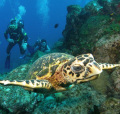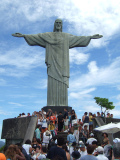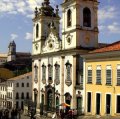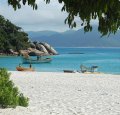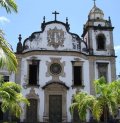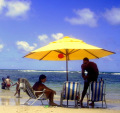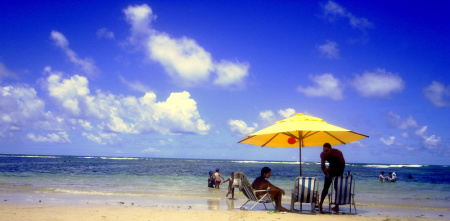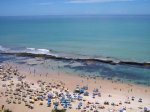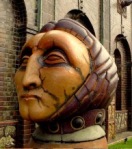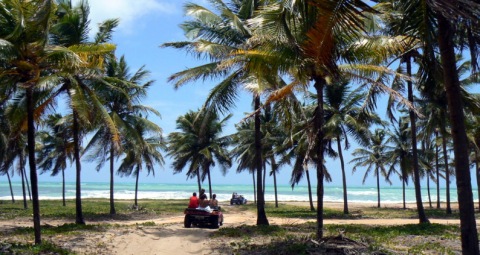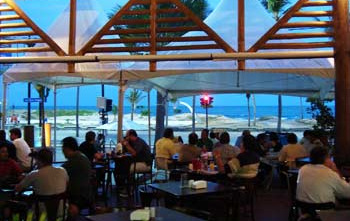Rio de Janeiro
 Saturday, February 6, 2010 at 08:18AM
Saturday, February 6, 2010 at 08:18AM 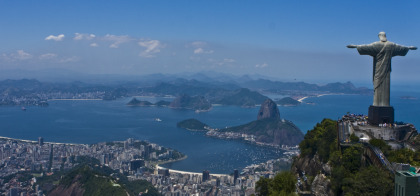
Rio de Janeiro, photo by Anh Già.
Rio de Janeiro (River of January) is the second biggest city in Brazil after São Paulo, but it is the most famous. It is also the capital of the State of Rio de Janeiro, and was the country´s capital for almost two hundred years, until 21st April 1960 when Brasilia became capital.
Rio is famous for many things: carnival and Bossa Nova music style (Girl from Ipanema), Carmen Miranda, and much more. It is also a tourist paradise for sun worshippers and those who like to party. The famous beaches of Copacabana and Ipanema, and the famous landmarks of Sugar Loaf Mountain and the statue of Christ the Redeemer on the Corcovado Mountain, are some of the most iconic images in the world. That Rio is also home to the world’s largest, and second largest, urban forestsis less well known. Forest da Tijuca and Parque Estadual da Pedra Branca are almost adjacent to each other, near the city centre. Rio also has the famous Maracana football stadium, once the largest stadium in the world (a crowd of over 199,000 watched the 1950 World Cup Final), it will be just the second stadium to host a World Cup Final twice when the 2014 World Cup Final reaches its climax.

Rio will be busy over the next few years preparing for both the World Cup in 2104 and the Summer Olympics in 2016. Then will can also boast of being the first South American Country to host any Olympic Games. Large scale investment is planned to improve the cities infrastructure, and the city is also busy trying to overcome security concerns.

Maps
View Rio Sights & Attractions in a larger map
Short History
 On January (Janeiro) 1st 1502, the first European explorers set foot in Rio, arriving at what they thought was the mouth of a river (rio). The fleet was led by Pedro Álvares Cabral, and under the observation of the legendary Amerigo Vespucci (supposed founder of America). Cabral is also credited with founding Salvador Bahia further north along the coast. At the time of the first landing, the area was home to native Tupi, Puri, Botocudo and Maxakalí tribes.
On January (Janeiro) 1st 1502, the first European explorers set foot in Rio, arriving at what they thought was the mouth of a river (rio). The fleet was led by Pedro Álvares Cabral, and under the observation of the legendary Amerigo Vespucci (supposed founder of America). Cabral is also credited with founding Salvador Bahia further north along the coast. At the time of the first landing, the area was home to native Tupi, Puri, Botocudo and Maxakalí tribes.
The City of Rio was formerly established on March 1st 1565, but several invasion attempts followed on numerous occasions until the 18th Century, primarily by French pirates. It became a more important port than Salvador after the discovery of gold and diamonds in the neighbouring state of Minas Gerais. Along with sugar, these precious cargos were reason enough to transfer the Colonial Captaincy from Salvador in 1763. Later, Nepoleon´s threatened invasion of Portugal lead the noblemen and Portuguese Royal Family to take flight. They headed for Rio, arriving in 1808. As a result the city expanded rapidly. The Kingdom of Portugal made Rio it´s Capital, making ot the only European capital to be located outside of Europe. Rapid expansion resulted in many older inhabitants being simply evicted from their homes to make way for the new arrivals.
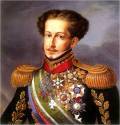 When Prince Pedro I proclaimed independence for Brazil (1822), Rio became Capital of his new empire. The empire lasted until 1889, when Brazil became a republic, and still Rio remained capital. A change in presidency in 1955 was followed by the implementation of Juscelino Kubitschek´s election promise to build a new capital city for the country. Brasilia was built quickly, and at great cost, in only 5years. On April 21st 1960 Brazil had a new Capital.
When Prince Pedro I proclaimed independence for Brazil (1822), Rio became Capital of his new empire. The empire lasted until 1889, when Brazil became a republic, and still Rio remained capital. A change in presidency in 1955 was followed by the implementation of Juscelino Kubitschek´s election promise to build a new capital city for the country. Brasilia was built quickly, and at great cost, in only 5years. On April 21st 1960 Brazil had a new Capital.
Do Not Miss
A visit to Rio has to include a visit to Copacabana beach
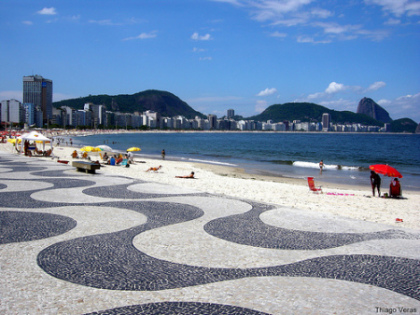 Copacabana photo by thiagoveras
Copacabana photo by thiagoveras
The beach of Ipanema is also "not to be missed".
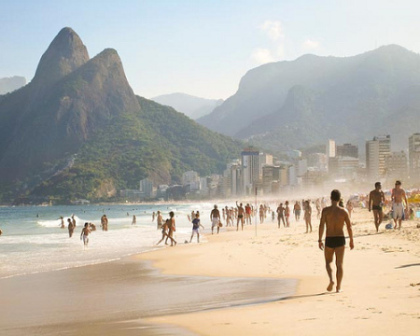 Ipanema, photo by gmichaelreilly.
Ipanema, photo by gmichaelreilly.
Other "must do" things in the city include a visit to the Statue of Christ the Redeemer. The easiest and fastest way up the mountain is by train. Queues do form at the station early in the morning when the coach parties all arrive. You can bus or taxi to near the top of Corcovado Mountain, but the last bit is on foot. From here you will see the true magnificence of the City of Rio – out into the ocean, across to Sugarloaf Mountain and the parks, forests, and lagoons that make this such a spectacle.
 Christ the redeemer, photo by londonmark
Christ the redeemer, photo by londonmark
The cable car takes you to the top of Sugarloaf for some of the most spectacular views of the city. It is actually two mountains, one larger than the other. The views at sunset can be stunning from here. If you have enough in the budget then a helicopter excursion across the city is highly recommended. You’ll have close up fly by’s of all the famous landmarks with commentary in various languages.
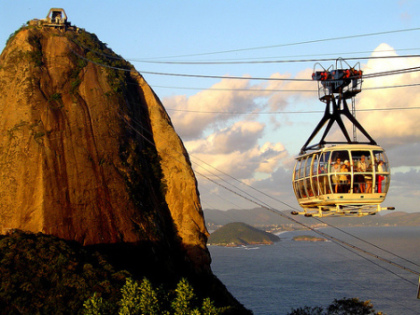 Sugar Loaf Mountain (Pão de Açucar), photo alestaleiro
Sugar Loaf Mountain (Pão de Açucar), photo alestaleiro
Rio´s carnival is world famous for a good reason. It is the biggest and most extravagant. The date of the four day party changes each year, but is usually in February. If you can plan a trip for this time of year you will witness one of the best street parties in the world, but be sure to plan well ahead if you don´t want to be disappointed.
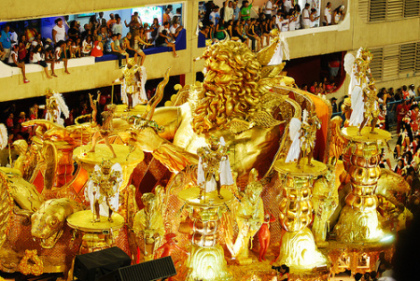 Carnival in Rio de Janeiro, photo by Tristan27
Carnival in Rio de Janeiro, photo by Tristan27
Other Top Attractions
 Lagoa Rodrigo Freitas, photo by Rodrigo_Soldon
Lagoa Rodrigo Freitas, photo by Rodrigo_Soldon
The large lagoon (Lagoa Rodrigo de Freitas), in the middle of South Zone, is ideal for jogging, walking, skating, sunbathing or boating. There are also great panoramic views of Rio to be seen.
Most tours and activities covered in the tours section of this guide, but highlights include:
The Tropical Island tour: Over 300 islands make up this archipelago to the south of Rio. Tour the islands by schooner boat, with time to sunbathe, take a dip in the clear seas and enjoy lunch which is included. A great way to relaxing in style and top up the tan!
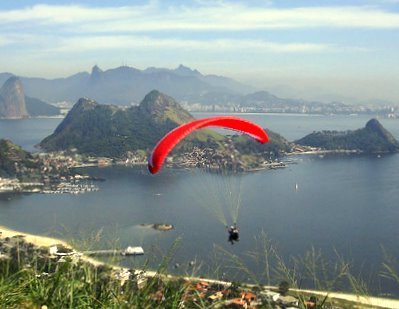 Paragliding Rio, photo by David (ddpf)
Paragliding Rio, photo by David (ddpf)
If you are feeling more adventurous, a hang-gliding or Para Gliding session gives you a true bird’s eye view of Rio´s landscape. enjoy the adrenalin rush at take off and at landing, and the breathtaking views whilst airborne.
For a taste of the history of Rio, take the Santa Teresa tour. It is a walk around the old town area, with its colonial architecture, Latin beats and the smells of true Brazilian cooking, it is a tour for your senses. See where the museums, churches and local craft shops and old houses along cobblestone streets. At the end of the tour you will jump on the last tram for the 45 minute ride back to downtown central.
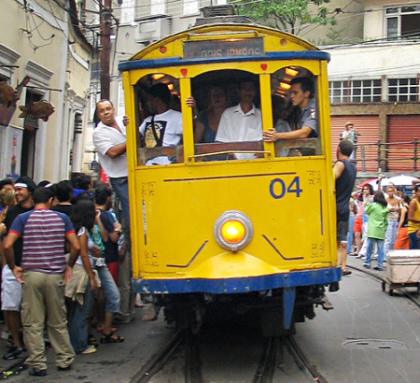 Bondinho de Santa Teresa [Tram in Santa Teresa], photo by Jim Skea.
Bondinho de Santa Teresa [Tram in Santa Teresa], photo by Jim Skea.
Many football fanatics include the Maracana Stadium on the "must see" list of Rio. You can book your transport to and from the stadium and watch a match being played by one of the four local teams - Flamengo, Fluminense, Botafogo and Vasco da Gama. Evening games are the most spectacular in this giant stadium that boils with the passion of the Latin blooded crowd during big games!
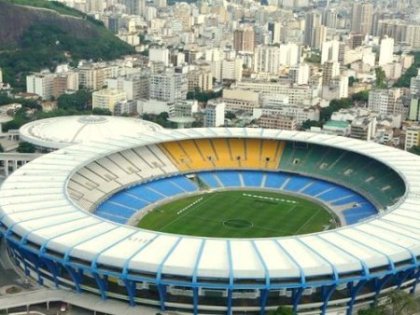 Maracana Stadium, photo by Around the rings1992
Maracana Stadium, photo by Around the rings1992
Nature and wildlife enthusiasts will enjoy a visit to Botanical Gardens and a Tijuca Forest Jeep Tour. The noteworthy plant species in the botanical garden include imperial palm trees, huge water lilies (Victorias-Regias), and some redwood trees (Pau Brasil), from whcih the country gets it´s name. These are almost extinct in the Atlantic forest. Visitors can also see more than 500 kinds of orchids in the greenhouse.
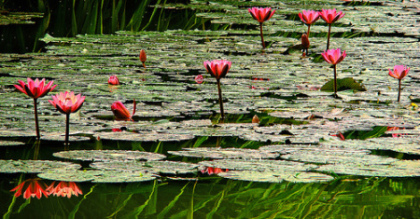 Botanical Garden, photo by Miriam Cardoso de Souza
Botanical Garden, photo by Miriam Cardoso de Souza
Tijuca National Park is home to the biggest urban forest in the world. it is best viewed during a jeep tour conducted by a well-trained team. Guides specialise in ecotourism. There are also points in the tour to enjoy the panoramic views of places like Ipanema and Copacabana beaches, Guanabara Bay and Sugar Loaf Mountain.
Attraction is perhaps not the right word to describe Rio´s many favela´s, but a characteristic sight of Rio they definitely are. These shanty towns can be visited, but only with a guide. Each tourist must make up their own mind about the wisdom and ethics of this kind of tourism. Information can be found via the tours section below.
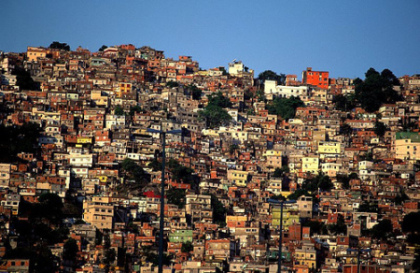 Rocinha, photo by miguel valle de figueiredo.
Rocinha, photo by miguel valle de figueiredo.
Accommodations
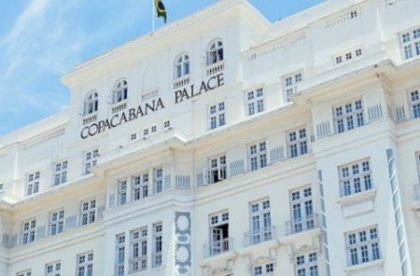
As you might expect, there is a great choice of accommodation in Rio within all price brackets. But, as you may also expect, Rio is not cheap. For many it is the start or end of their holiday, and they don´t mind the extra cost for a few days. And, for sure Rio is s city not to be missed.
We have listed accommodations in 3 categories:
You can also choose by location via our interactive maps, one for each price range.
Tours
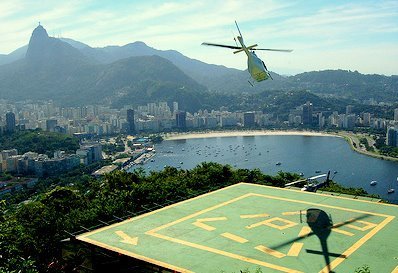 Helicopter Tour, photo by Primetime22
Helicopter Tour, photo by Primetime22
There are a huge number of tours to choose from in Rio. We will soon add a listing with links so you can book online.
Bars, Clubs, Cafes and Restaurants
There are so many bars, cafes, restaurants and clubs in Rio it is hard to pick out just a few to mention.
All the way along the beaches of Leblon, Ipanema and Copacabana you will find places to eat, to drink, and to dance. Some of the quirkier and more authentic bars are further away from the beach areas in some of the side streets of Rio. There are lots of very affordable places, some more sophisticated places. Please see the map for a few offerings we picked out, but for a more detailed view please visit www.ipanema.com
Gay Rio
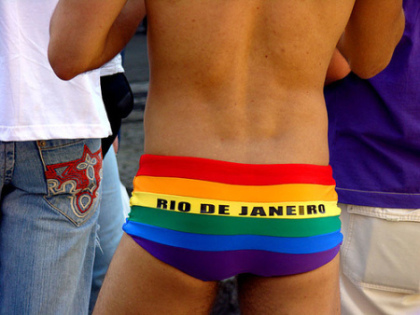 photo by Marcel Bely
photo by Marcel Bely
A Guide to Rio must include the Gay scene, for Rio is one of the Top Gay destinations in the world. Only Sydney competes for the number 1 spot. It is very easy to fall in love with Rio and some of its inhabitants. The hot weather, the hot beaches and the hot bodies – it has them all.
There are many Gay owned or operated places to eat, drink, dance, and meet. Carnival is when the City is at its most colourful, but you are always likely to see brightly ordained drag queens promenading the Copacabana or Ipanema scene.
The beach is the best place to go make new gay friends and find out what is happening. The gay point on the beach is Farme (part of Ipanema beach just to the east of Rua Farme de Amoeda, also known as Barbie land. This is an affectionate term used for the muscled, wealthy guys from Southside Rio who visit the area. It is a very relaxed and cosmopolitan crowd, and affection can be shown without any fear. Gays and Lesbians take the heat of the sun by day and the cool drinks in the bars at night.
There are a wide range of activities available to gay visitors, including the bars and clubs, hotels, cinemas, saunas, cruising grounds, and motels. See www.riogayguide.com for more information and maps.
Events
Rio Carnival the most spectacular Carnival experience. Four incredible days. Amazing costumes, elaborate floats, dancing and music. (February 13 – 17, 2010). www.ipanema.com/carnival
National Samba Day, Dec 1 - A big samba Parade from Central do Brazil station to Oswaldo Cruz, Various venues, 21 217 7632 (Tourism Office).
Parada Iluminada, Dec 20th - a parade along Copacabana Beach, colourful costumes, plenty of music and dancing. http://www.paradailuminada.com.br
New Years Eve Fireworks, Dec 31st, Copacabana, a huge celebration along the whole length of the beach with many stages, live music, DJs and dancing.
See also www.ipanema.com
Safety
Safety is an issue, but do not let this stop you visiting one of the most incredible cities in the world. You should dress down; avoid carrying too much cash and not wear or carrying expensive sun glasses, watches, jewellery, sneakers, cell phones etc, or those that may look expensive. Also avoid areas of the city you are not familiar with unless you have taken local advice. If you are unlucky enough to be robbed do not resist.
Getting There
By Plane
Rio´s International airport is Antonio Carlos Jobim International Airport (Code GIG). Tel. +55 (0)21 3984597. It is located on the far suburbs of the city, and is served by many national and international airlines. Ground transportation is by bus, airport taxi, or transfer arranged with your hotel. An airport information desk will advise you of the options and costs. It is better not to arrive late because transfers to the city do not operate 24hrs because of security problems in some areas between the airport and the city.
Rio´s City Airport, Santos Dumont Airport (Code SDU). +55 (0)21 2102457. It is located in the heart of the city, and is served by regional airlines. Ground transportation is easy by taxi to most tourist hotspots.
By Bus
An Inter-State bus station in Brazil is called a Rodoviaria. The one in Rio is Terminal Novo Rio +55 (0)21 3213-1800, and is located at Av. Francisco Bicalho, 1 - Santo Cristo. That is approximately half way between Copacabana and Ipanema, or approx. 20-30mins by taxi. An information desk will give you details of other options. It is better to avoid travelling at night. Map
By Car
Google maps are the best way to work out a route and get an idea of the length of your journey and the time it will take. Go to Google Maps and select "Get Directions". Then, enter a start point (A) and a destination point (B), plus a mode of transport.
 Brazzil Travel | Comments Off |
Brazzil Travel | Comments Off |  Rio de Janeiro in
Rio de Janeiro in  Adventure & Activity,
Adventure & Activity,  Art, Architecture & Design,
Art, Architecture & Design,  Beach,
Beach,  City,
City,  Cruises & Sailing,
Cruises & Sailing,  Culture,
Culture,  Destinations,
Destinations,  Eco & Ethical,
Eco & Ethical,  Family,
Family,  Festivals & Events,
Festivals & Events,  Gastronomy,
Gastronomy,  Gay & Lesbian,
Gay & Lesbian,  Health & Well-Being,
Health & Well-Being,  Heritage,
Heritage,  History & Culture,
History & Culture,  Honeymoon,
Honeymoon,  Journeys,
Journeys,  Luxury,
Luxury,  Music,
Music,  Nature & Wildlife,
Nature & Wildlife,  News,
News,  Photography,
Photography,  Rest & Relaxation,
Rest & Relaxation,  Romantic,
Romantic,  Solo Travel,
Solo Travel,  Sport,
Sport,  Surf,
Surf,  Water Sport
Water Sport 